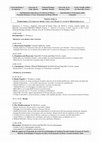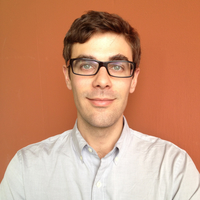Papers by Elena Gabriella Lorenzetti
In summer 2011 a fourth season of excavation at the site of the Vicus Martis Tudertium was conduc... more In summer 2011 a fourth season of excavation at the site of the Vicus Martis Tudertium was conducted in the area to the north of that already investigated. Building remains exhibited similar preservation as that already found to the south, and small finds were also consistent with those from previous seasons. The earliest material found pushes back the site’s date slightly, into the late second century BCE. Despite a rising ground level, excavation again reached the water table.
Over the course of the past three seasons (2012-2014) at the putative site of the Vicus Martis Tu... more Over the course of the past three seasons (2012-2014) at the putative site of the Vicus Martis Tudertium near the church of S. Maria in Pantano (Massa Martana, PG), excavation has focused on a large structure first observed in crop marks in fall 2008. We have uncovered a large building oriented along the putative Via Flaminia and possessing an apse at its eastern end, the precise function of which remains unclear. Excavation has also uncovered a series of early-medieval burials located just east of the structure.
Over the course of the past three seasons (2012-2014) at the putative site of the Vicus Martis Tu... more Over the course of the past three seasons (2012-2014) at the putative site of the Vicus Martis Tudertium near the church of S. Maria in Pantano (Massa Martana, PG), excavation has focused on a large structure first observed in crop marks in fall 2008. We have uncovered a large building oriented along the putative Via Flaminia and possessing an apse at its eastern end, the precise function of which remains unclear. Excavation has also uncovered a series of early-medieval burials located just east of the structure.
In summer 2011 a fourth season of excavation at the site of the Vicus Martis Tudertium was conduc... more In summer 2011 a fourth season of excavation at the site of the Vicus Martis Tudertium was conducted in the area to the north of that already investigated. Building remains exhibited similar preservation as that already found to the south, and small finds were also consistent with those from previous seasons. The earliest material found pushes back the site’s date slightly, into the late second century BCE. Despite a rising ground level, excavation again reached the water table.
Conferences by Elena Gabriella Lorenzetti

by Clementina Panella, Antonio F. Ferrandes, Paul Reynolds, Alessandra Pecci, Touatia Amraoui, Elyssa Jerray, alessia contino, Marta Casalini, Franca Del Vecchio, Viviana Cardarelli, George Koutsouflakis, Tomoo Mukai, Elizabeth Fentress, Priamo Antonio Manna, Alejandro Quevedo, and Elena Gabriella Lorenzetti An imposing amount of studies and researches in the second half of the twentieth century has focu... more An imposing amount of studies and researches in the second half of the twentieth century has focused on the productivity in Roman Africa of a variety of consumer products, along with the analysis of regions, cities and their economies. The success of African goods during the Caesarian-Augustan age and up to the late antiquity, recorded in the written tradition and confirmed by the stratigraphy of many sites in the Mediterranean, has been the subject of a substantial amount of contributions that have accompanied for more than sixty years the study of material culture of the Roman imperial age. This session, which can not consider every product of the Maghreb, will focus mainly on the ceramic, not only on account of its large diffusion, the fossil marker for dating contexts all around the Mediterranean and well inside Europe for several centuries, but also because the evidence is more consistent than that found for other types of sources, and reflects the ability of African regions to develop a high yield agriculture, and manufacturing activities related to fisheries, as shown by transport amphorae (carrying oil, olives, wine, fish sauces), as well as crafts tied to the production of more or less valuable objects, aimed - at various levels - at regional, inter-regional and inter-provincial markets.
If during a more or less recent past most studies were mainly focused on data collected at the sites of consumption (and thus on the indestructible ceramic), centered on the type and histories of each production (fine table ware, lamps, kitchenware and coarse ware), recent studies have been, on one hand, directed towards a review of the known types and towards a more thoughtful analysis of the contexts of discovery, perfecting the production framework and anchoring to a trustworthy time frame certain types and classes in circulation; on the other hand they have focused on the production centers in order to get a better geographic characterization of those same types and classes, applying a wealth of suitable methodologies, surveys of large tracts of land, surveys and excavations of old and new workshops, laboratory analysis. The results draw a scenery in which a great variety of productive facies and distribution models reflect the complexity of the cultural, social and economic contexts, both micro- and macro-regional, both at the provincial and inter-provincial levels. This session aims to describe these lines of research, focusing on the organization of production and commerce in the region, their similarities and differences, and on a list of questions still unsolved, the solution of which will call for a further revision of published data, and for brand new information.









Uploads
Papers by Elena Gabriella Lorenzetti
Conferences by Elena Gabriella Lorenzetti
If during a more or less recent past most studies were mainly focused on data collected at the sites of consumption (and thus on the indestructible ceramic), centered on the type and histories of each production (fine table ware, lamps, kitchenware and coarse ware), recent studies have been, on one hand, directed towards a review of the known types and towards a more thoughtful analysis of the contexts of discovery, perfecting the production framework and anchoring to a trustworthy time frame certain types and classes in circulation; on the other hand they have focused on the production centers in order to get a better geographic characterization of those same types and classes, applying a wealth of suitable methodologies, surveys of large tracts of land, surveys and excavations of old and new workshops, laboratory analysis. The results draw a scenery in which a great variety of productive facies and distribution models reflect the complexity of the cultural, social and economic contexts, both micro- and macro-regional, both at the provincial and inter-provincial levels. This session aims to describe these lines of research, focusing on the organization of production and commerce in the region, their similarities and differences, and on a list of questions still unsolved, the solution of which will call for a further revision of published data, and for brand new information.
If during a more or less recent past most studies were mainly focused on data collected at the sites of consumption (and thus on the indestructible ceramic), centered on the type and histories of each production (fine table ware, lamps, kitchenware and coarse ware), recent studies have been, on one hand, directed towards a review of the known types and towards a more thoughtful analysis of the contexts of discovery, perfecting the production framework and anchoring to a trustworthy time frame certain types and classes in circulation; on the other hand they have focused on the production centers in order to get a better geographic characterization of those same types and classes, applying a wealth of suitable methodologies, surveys of large tracts of land, surveys and excavations of old and new workshops, laboratory analysis. The results draw a scenery in which a great variety of productive facies and distribution models reflect the complexity of the cultural, social and economic contexts, both micro- and macro-regional, both at the provincial and inter-provincial levels. This session aims to describe these lines of research, focusing on the organization of production and commerce in the region, their similarities and differences, and on a list of questions still unsolved, the solution of which will call for a further revision of published data, and for brand new information.